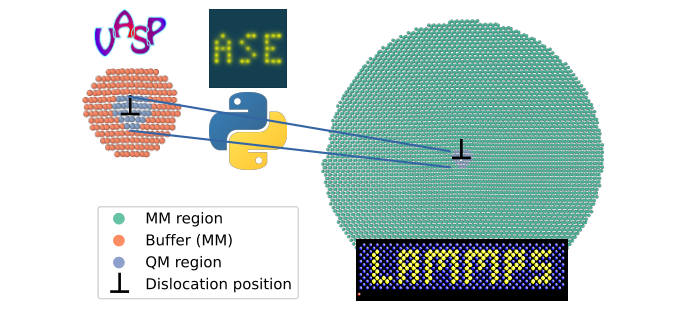dislocations
towards QM accuracy
Dislocations are extended line defects which carry plastic deformation in crystalline materials . Understanding and optimizing dislocation behaviour by characterising dislocation interaction with point defects is a central topic in computational metallurgy . For this task, ab initio calculations, specifically density functional theory (DFT) , are essential to capture dislocation core structures and complex bonding to impurity elements. However, the computational cost of DFT typically scales with the number of atoms as \(\mathcal{O}(N^3)\) for metallic systems, which limits its direct applicability to the study of extended defects. Within this project I develop and apply hybrid QM/MM methods which allow to study unfeasibly large systems with ab initio accuracy.
QM/MM coupling scheme.
Hybrid QM/MM coupling scheme practically requires running two simulations in parallel: LAMMPS for MM part and VASP for DFT cell while the coupling is implemented with python ASE interface. The QM/MM forcs \(\bf F_{\mathrm{QM/MM}}\) is obtained by mixing MM force \(\bf F_{\mathrm{LAMMPS}}\) with ab initio force \(\bf F_\mathrm{VASP}\) with simple relation:
\[\bf F_{\mathrm{QM/MM}} = \begin{cases} \bf F_{\mathrm{VASP}} , & \bf X \in \mathrm{QM} \\ \bf F_{\mathrm{LAMMPS}}, & \mathrm{otherwise} \end{cases}\] where \(\bf X\) is atomic coordinates vector and \(\mathrm{QM}\) denotes QM region shown with blue color. The position of the atoms are then updated according to the QM/MM force \(\bf F_{\mathrm{QM/MM}}\) during ionic minimisation. An important aspect of hybrid QM/MM simulations is the need to have a buffer of sacrificial DFT atoms (shown with orange color), suitably large to protect the target cluster from electronic free surface effects.
This method provides a unique tool to study dislocations with ab initio accuracy . Moreover, further extension of the capabilities is possible by combination of the method with recent developments in machine learning based force fields . Exploration of this possibility is the main topic of this project.
